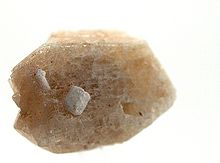
Back Anortoklaas Afrikaans Anortoclasa Catalan Anorthoklas German Ανορθόκλαστο Greek Anortoclasio Italian アノーソクレース Japanese ანორთოკლაზი Georgian Анортоклаз Kazakh Anorthoklaas Dutch Anortoklas NN
| Anorthoclase | |
|---|---|
 Doubly terminated anorthoclase crystal from Kinki Region, Honshu, Japan. Size: 1.3 cm × 0.9 cm × 0.7 cm (0.5 in × 0.4 in × 0.3 in) | |
| General | |
| Category | Feldspar |
| Formula (repeating unit) | (Na,K)AlSi3O8 |
| IMA symbol | Ano[1] |
| Strunz classification | 9.FA.30 |
| Crystal system | Triclinic |
| Crystal class | Pinacoidal (1) (same H–M symbol) |
| Space group | C1 |
| Unit cell | a = 8.28, b = 12.97 c = 7.15 [Å]; α = 91.05° β = 116.26°, γ = 90.15°; Z = 4 |
| Identification | |
| Color | Colorless, also white, pale creamy yellow, red, green |
| Crystal habit | Short prismatic crystals; tabular, rhombic, flattened along [010] |
| Twinning | Polysynthetic twinning produces a grid pattern on [100] |
| Cleavage | Perfect on [001], other partings |
| Fracture | Uneven |
| Tenacity | Brittle |
| Mohs scale hardness | 6 |
| Luster | Vitreous to pearly on cleavage planes |
| Streak | White |
| Diaphaneity | Transparent |
| Specific gravity | 2.57–2.60 |
| Optical properties | Biaxial (−) |
| Refractive index | nα = 1.519–1.529 nβ = 1.524–1.534 nγ = 1.527–1.536 |
| Birefringence | δ = 0.008 |
| 2V angle | Measured: 34°–60° |
| References | [2][3][4] |
The mineral anorthoclase ((Na,K)AlSi3O8) is a crystalline solid solution in the alkali feldspar series, in which the sodium-aluminium silicate member exists in larger proportion. It typically consists of between 10 and 36 percent of KAlSi3O8 and between 64 and 90 percent of NaAlSi3O8.[5]

- ^ Warr, L.N. (2021). "IMA–CNMNC approved mineral symbols". Mineralogical Magazine. 85 (3): 291–320. Bibcode:2021MinM...85..291W. doi:10.1180/mgm.2021.43. S2CID 235729616.
- ^ "Handbook of Mineralogy" (PDF). Archived from the original (PDF) on 2016-03-04. Retrieved 2011-12-04.
- ^ "Mindat.org".
- ^ "Webmineral data".
- ^ Deere; Howie; Zussman. Framework Silicates. Rock Forming Minerals. Vol. 4. Wiley. pp. 2–5, Fig. 1.